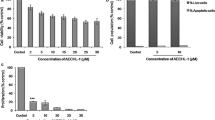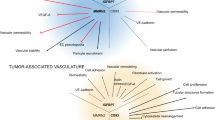Abstract
Nucleolin is specifically transported to the surface of proliferating endothelial cells in vitro and in vivo. In contrast to its well defined functions in the nucleus and cytoplasm, the function of cell surface nucleolin is poorly defined. We have previously identified the nucleolin-binding antibody NCL3 that specifically binds to cell surface nucleolin on angiogenic blood vessels in vivo and is internalized into the cell. Here, we show that NCL3 inhibits endothelial tube formation in vitro as well as angiogenesis in the matrigel plaque assay and subcutaneous tumor models in vivo. Intriguingly, the specific targeting of proliferating endothelial cells by NCL3 in subcutaneous tumor models leads to the normalization of the tumor vasculature and as a result to an increase in tumor oxygenation. Treatment of endothelial cells with anti-nucleolin antibody NCL3 leads to a decrease of mRNA levels of the anti-apoptotic molecule Bcl-2 and as a consequence induces endothelial cell apoptosis as evidenced by PARP cleavage. These data reveal a novel mode of action for anti-angiogenic therapy and identify cell surface nucleolin as a novel target for combinatorial chemotherapy.






Similar content being viewed by others
References
Hanahan D, Folkman J (1996) Patterns and emerging mechanisms of the angiogenic switch during tumorigenesis. Cell 86(3):353–364. doi:10.1016/S0092-8674(00)80108-7
Ruoslahti E (2002) Specialization of tumour vasculature. Nat Rev Cancer 2(2):83–90. doi:10.1038/nrc724
St Croix B, Rago C, Velculescu V et al (2000) Genes expressed in human tumor endothelium. Science 289(5482):1197–1202. doi:10.1126/science.289.5482.1197
Fukumura D, Jain RK (2007) Tumor microvasculature and microenvironment: targets for anti-angiogenesis and normalization. Microvasc Res 74(2–3):72–84. doi:10.1016/j.mvr.2007.05.003
Ferrara N, Hillan KJ, Gerber HP et al (2004) Discovery and development of bevacizumab, an anti-VEGF antibody for treating cancer. Nat Rev Drug Discov 3(5):391–400. doi:10.1038/nrd1381
Christian S, Pilch J, Akerman ME et al (2003) Nucleolin expressed at the cell surface is a marker of endothelial cells in angiogenic blood vessels. J Cell Biol 163(4):871–878. doi:10.1083/jcb.200304132
Huang Y, Shi H, Zhou H et al (2006) The angiogenic function of nucleolin is mediated by vascular endothelial growth factor and nonmuscle myosin. Blood 107(9):3564–3571. doi:10.1182/blood-2005-07-2961
Destouches D, El Khoury D, Hamma-Kourbali Y et al (2008) Suppression of tumor growth and angiogenesis by a specific antagonist of the cell-surface expressed nucleolin. PLoS ONE 3(6):e2518. doi:10.1371/journal.pone.0002518
Ginisty H, Sicard H, Roger B et al (1999) Structure and functions of nucleolin. J Cell Sci 112(Pt 6):761–772
Srivastava M, Pollard HB (1999) Molecular dissection of nucleolin’s role in growth and cell proliferation: new insights. FASEB J 13(14):1911–1922
Borer RA, Lehner CF, Eppenberger HM et al (1989) Major nucleolar proteins shuttle between nucleus and cytoplasm. Cell 56(3):379–390. doi:10.1016/0092-8674(89)90241-9
Yu D, Schwartz MZ, Petryshyn R (1998) Effect of laminin on the nuclear localization of nucleolin in rat intestinal epithelial IEC-6 cells. Biochem Biophys Res Commun 247(1):186–192. doi:10.1006/bbrc.1998.8754
Harms G, Kraft R, Grelle G et al (2001) Identification of nucleolin as a new L-selectin ligand. Biochem J 360(Pt 3):531–538. doi:10.1042/0264-6021:3600531
Said EA, Krust B, Nisole S et al (2002) The anti-HIV cytokine midkine binds the cell surface-expressed nucleolin as a low affinity receptor. J Biol Chem 277(40):37492–37502. doi:10.1074/jbc.M201194200
Sinclair JF, O’Brien AD (2002) Cell surface-localized nucleolin is a eukaryotic receptor for the adhesin intimin-gamma of enterohemorrhagic Escherichia coli O157:H7. J Biol Chem 277(4):2876–2885. doi:10.1074/jbc.M110230200
Fahling M, Steege A, Perlewitz A et al (2005) Role of nucleolin in posttranscriptional control of MMP-9 expression. Biochim Biophys Acta 1731(1):32–40
Otake Y, Soundararajan S, Sengupta TK et al (2007) Overexpression of nucleolin in chronic lymphocytic leukemia cells induces stabilization of bcl2 mRNA. Blood 109(7):3069–3075
Soundararajan S, Chen W, Spicer EK et al (2008) The nucleolin targeting aptamer AS1411 destabilizes Bcl-2 messenger RNA in human breast cancer cells. Cancer Res 68(7):2358–2365. doi:10.1158/0008-5472.CAN-07-5723
Shi H, Huang Y, Zhou H et al (2007) Nucleolin is a receptor that mediates antiangiogenic and antitumor activity of endostatin. Blood 110(8):2899–2906. doi:10.1182/blood-2007-01-064428
Fulgham DL, Widhalm SR, Martin S et al (1999) FGF-2 dependent angiogenesis is a latent phenotype in basic fibroblast growth factor transgenic mice. Endothelium 6(3):185–195. doi:10.3109/10623329909053409
Ngo CV, Gee M, Akhtar N et al (2000) An in vivo function for the transforming Myc protein: elicitation of the angiogenic phenotype. Cell Growth Differ 11(4):201–210
Zhang J, Tsaprailis G, Bowden GT (2008) Nucleolin stabilizes Bcl-X L messenger RNA in response to UVA irradiation. Cancer Res 68(4):1046–1054. doi:10.1158/0008-5472.CAN-07-1927
Morikawa S, Baluk P, Kaidoh T et al (2002) Abnormalities in pericytes on blood vessels and endothelial sprouts in tumors. Am J Pathol 160(3):985–1000
Dhanabal M, Ramchandran R, Waterman MJ et al (1999) Endostatin induces endothelial cell apoptosis. J Biol Chem 274(17):11721–11726. doi:10.1074/jbc.274.17.11721
Abdollahi A, Hahnfeldt P, Maercker C et al (2004) Endostatin’s antiangiogenic signaling network. Mol Cell 13(5):649–663. doi:10.1016/S1097-2765(04)00102-9
Jain RK (2005) Antiangiogenic therapy for cancer: current and emerging concepts. Oncology 19(4, Suppl 3):7–16 Williston Park
Dickson PV, Hamner JB, Sims TL et al (2007) Bevacizumab-induced transient remodeling of the vasculature in neuroblastoma xenografts results in improved delivery and efficacy of systemically administered chemotherapy. Clin Cancer Res 13(13):3942–3950. doi:10.1158/1078-0432.CCR-07-0278
Hamzah J, Jugold M, Kiessling F et al (2008) Vascular normalization in Rgs5-deficient tumours promotes immune destruction. Nature 453(7193):410–414. doi:10.1038/nature06868
Winkler F, Kozin SV, Tong RT et al (2004) Kinetics of vascular normalization by VEGFR2 blockade governs brain tumor response to radiation: role of oxygenation, angiopoietin-1, and matrix metalloproteinases. Cancer Cell 6(6):553–563
Jain RK (2008) Lessons from multidisciplinary translational trials on anti-angiogenic therapy of cancer. Nat Rev Cancer 8(4):309–316. doi:10.1038/nrc2346
Herbst RS, O’Neill VJ, Fehrenbacher L et al (2007) Phase II study of efficacy and safety of bevacizumab in combination with chemotherapy or erlotinib compared with chemotherapy alone for treatment of recurrent or refractory non small-cell lung cancer. J Clin Oncol 25(30):4743–4750. doi:10.1200/JCO.2007.12.3026
Sandler A, Gray R, Perry MC et al (2006) Paclitaxel-carboplatin alone or with bevacizumab for non-small-cell lung cancer. N Engl J Med 355(24):2542–2550. doi:10.1056/NEJMoa061884
Acknowledgments
We thank Dr Masanobu Komatsu for comments on the manuscript and Dr William Stallcup for providing the anti NG2 antibody. V. Fogal received support from the Susan Komen Foundation.
Author information
Authors and Affiliations
Corresponding author
Rights and permissions
About this article
Cite this article
Fogal, V., Sugahara, K.N., Ruoslahti, E. et al. Cell surface nucleolin antagonist causes endothelial cell apoptosis and normalization of tumor vasculature. Angiogenesis 12, 91–100 (2009). https://doi.org/10.1007/s10456-009-9137-5
Received:
Accepted:
Published:
Issue Date:
DOI: https://doi.org/10.1007/s10456-009-9137-5




